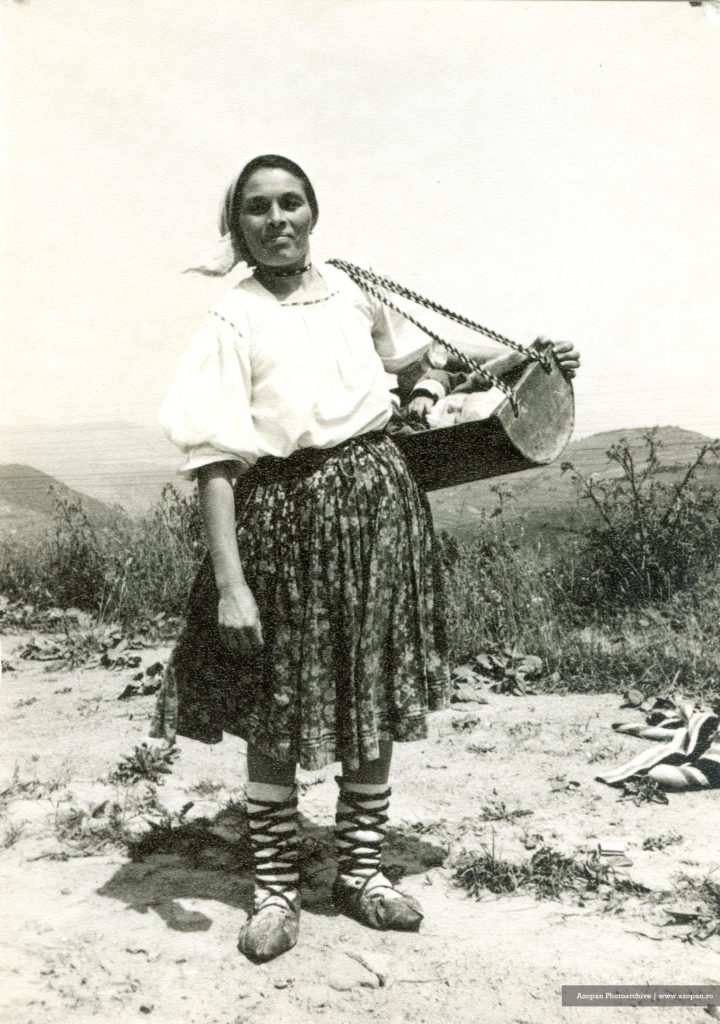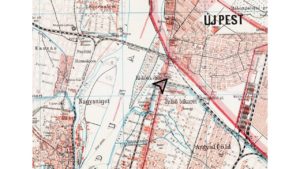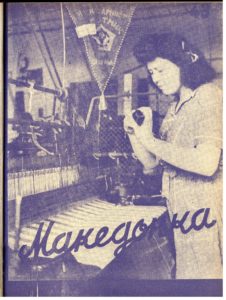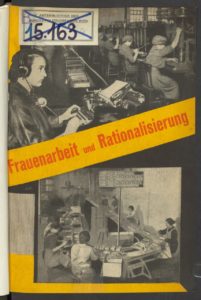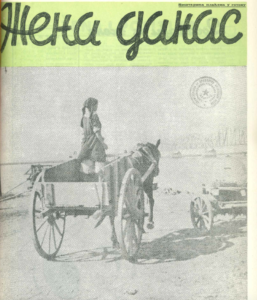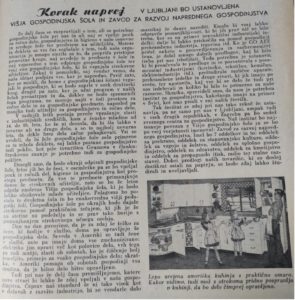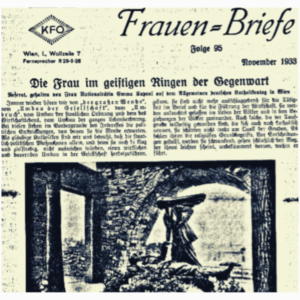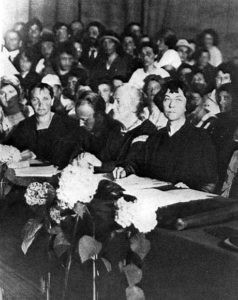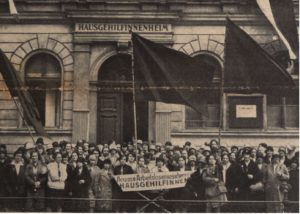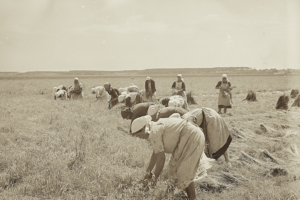by Adela Hîncu
By the 1960s, statistics clearly showed that the proportion of women working in agriculture in state socialist Romania was growing. In an article from 1978, sociologist Mihail Cernea described this trend as the “feminization of agriculture.” He argued that it was a “major unpredicted phenomenon” or a “latent function” of the macroeconomic policy to pursue agricultural collectivization together with rapid industrialization in Romania.[1] This was not an undisputed claim. In an article published the same year, economist William Moskoff, who had conducted research in the country in 1976 with a Fulbright scholarship, pondered whether women’s “subordinate situation” within the Romanian economy was an unintended consequence or the result of conscious policy design. Moskoff concluded that it was both, but that ultimately women’s economic role was more important to planners than women’s emancipation.[2] In 1990, sociologist Natalia Damian revisited the question in an issue on the “feminization of agriculture” which she edited for the International Review of Sociology. Together with fellow sociologist and husband Liviu Damian, they argued with reference to Cernea’s work that the “feminization of agriculture” was in fact a misnomer for the stark gender inequality driving Romania’s macroeconomic policy.[3]
In what follows, I analyze this debate on the “feminization of agriculture” from a history of knowledge perspective. On the one hand, I argue that Cernea’s work should be understood in the complex intellectual and institutional context of sociological research in state socialist Romania, which Natalia and Liviu Damian’s criticism simplified to a distinction between ideologically driven theoretical work and empirical research without theory. On the other hand, I show that this framing of the debate illuminates some of the underlying intentions of Natalia Damian’s reflections at the beginning of the 1970s on how the relationship between theory and empirical methodology rendered women sociologically invisible. These reflections were akin to discussions about feminist methodology in Western social science at the time.
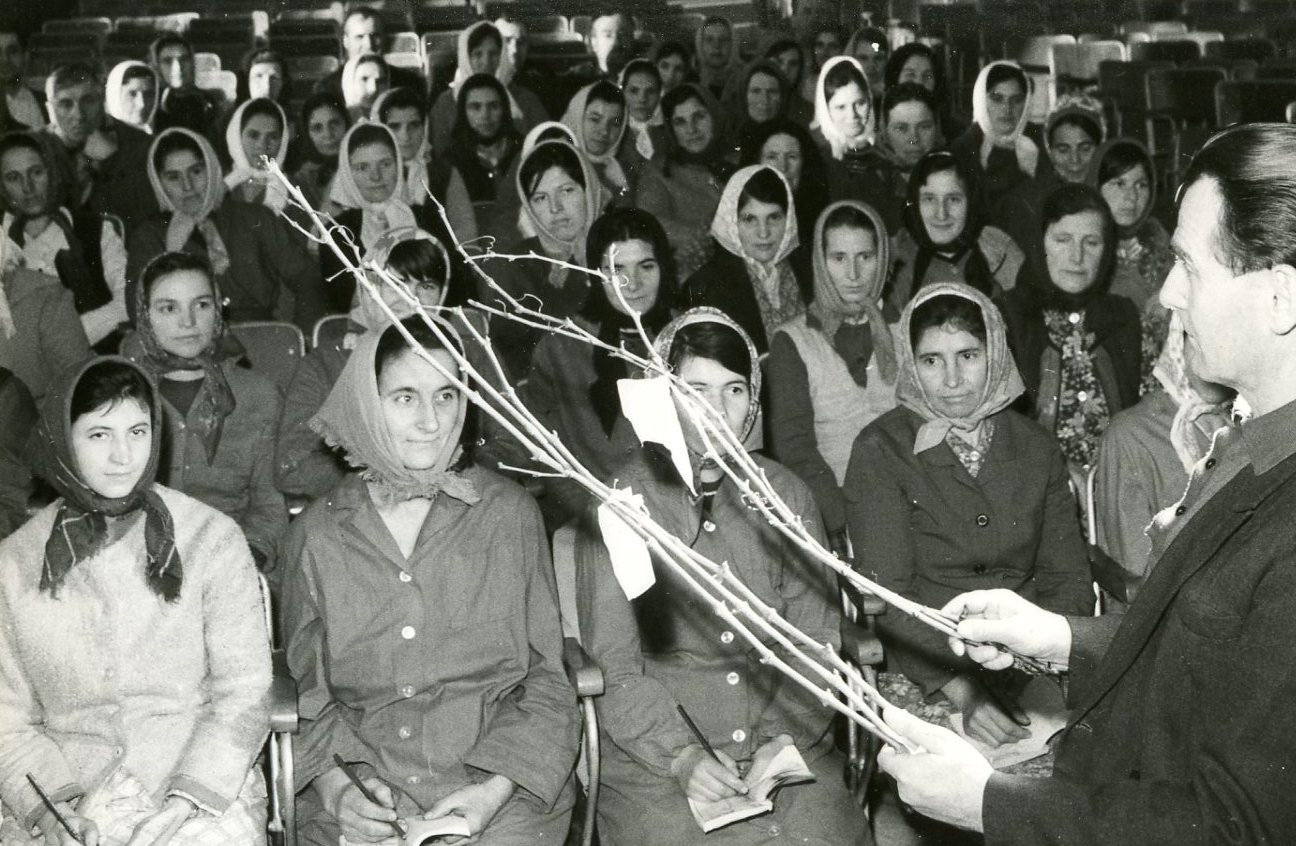
I.
In the early 1960s, Cernea was part of the first team of philosophy-trained researchers who started conducting empirical sociological studies in Romania. In the 1960s and 1970s, such research substantiated but also subverted concepts of “dogmatic” Marxism-Leninism, “socialist consciousness,” or the “social homogenization” of socialist society, among others. Cernea was concerned with the changing structure of families as a result of collectivization and industrialization, and incorporated several intellectual sources in his research.[4] First, he built on interwar studies about the transformation of communal forms of rural organization under capitalism in Romania.[5] Against their background, Cernea described the ways in which the socialist collectivization of agriculture changed the distribution of rural family members’ economic and social roles, beginning to shift entrenched patriarchal structures.[6] He also drew on contemporary French rural sociology. And finally, as almost everywhere in Eastern Europe, American structural functionalism became a major source of theoretical engagement for Romanian sociologists beginning in the second half of the 1960s. This happened first via critical introductions of the American scholarship, such as a book by Cernea’s late wife, Stela Cernea.
As a fellow at the Center for Advanced Study in Behavioral Studies, University of Stanford, in 1970–71, Cernea expanded his knowledge of contemporary American sociology. Before emigrating from Romania in 1974, he wrote a study in which he applied the theory of formal organizations to the socialist agricultural cooperative. To account for the negative consequences of collectivization, Cernea employed Robert Merton’s concept of “latent function,” whose work he preferred over classical structural functionalism. Based on Stela Cernea’s work, he argued that the latter “justified ideologically the existing social system.”[7] Whereas the formulation originally referred to the capitalist system, it is possible to infer that in this context, it was the state socialist system that Cernea did not want to simply justify. His analysis of the consequences of collectivization on family structures and the economic roles of rural women as a “latent function” of macroeconomic change was criticized in 1990 by Natalia and Liviu Damian for legitimizing regime ideology. However, seen in its 1970s intellectual context, it functioned as an ideologically acceptable way to articulate criticism. In his article on the “feminization of agriculture,” Cernea argued that collectivization had improved women’s position in the family as decision-makers even while old patriarchal values persisted (e.g., rural women received less education and had less access to management positions than rural men). At the same time, he claimed, collectivization had created new constraints on women’s time and social mobility, given their triple economic role as workers on the cooperative farm, the family plot, and in the household.[8]
II.
In their article from 1990, Natalia and Liviu Damian disputed much of Cernea’s analysis. Relying on comparative and empirical data that extended a decade beyond the temporal scope of Cernea’s work, they argued that it was not just proportional “feminization,” but qualitative, “striking polarization” that defined socialist agriculture in Romania. By “striking polarization” they meant that rural women were overwhelmingly represented in low-paid, low-status jobs, e.g., manual labour on individual family plots and in the cooperative,[9] as compared to managerial positions. Gender inequality, they argued, was systematic, not accidental, a fundamental characteristic of the political economy of Romania, not a latent function of centrally planned economic development. Further support for this interpretation stemmed from comparative analysis: Romania was one of the few socialist countries of Eastern Europe where the “feminization” persisted over time, while in the Soviet Union and Hungary, for example, the trend had been reversed.[10]
This fundamental disagreement about the political economy of state socialist Romania also had an epistemological dimension, reflected in Natalia and Liviu Damian’s review of local sociological research on rural women in Romania. They distinguished between macro-sociological analysis that minimized the realities of collectivization for women on the ground; and empirical research that fatefully described these realities but did not draw theoretical conclusions.[11] The tension between theory and empirical research had also preoccupied Natalia Damian in her sociological work in Romania, before emigrating to Israel at the end of the 1970s. Damian took part in a large-scale research project on urbanization carried out in the second half of the 1960s. Her conclusions regarding rural women at the time were very similar to Cernea’s: rural women improved their status within the family by becoming earners on the cooperative farm and gained more authority as their husbands were commuting and away from home for extended periods of time.[12]
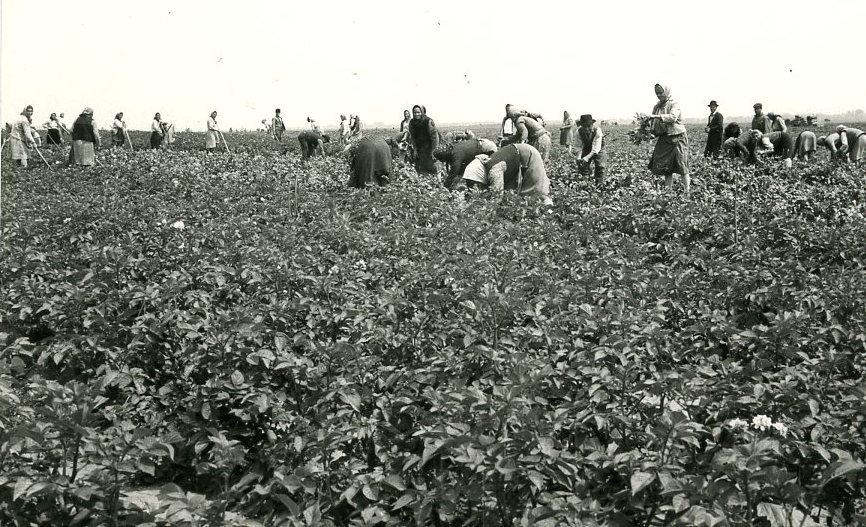
Yet Damian also reflected critically on the ways in which existing research methods reproduced pre-existing theoretical assumptions, rendering women invisible. Most notably, she pointed out that taking the head of the household to stand for the entire family in statistical analyses perpetuated the assumption that spouses mutually selected within sociological classification groups such as level of education or profession (a phenomenon she termed endogrouping).[13] Damian turned this epistemological bias into the very topic of research. She analyzed empirical data on endogrouping and concluded, on the one hand, that the practice of using data for the head of the household involved systematic distortion.[14] On the other hand, Damian found that marital choices were not just the result of individual preferences, but were sociologically meaningful. Namely, they pointed out existing structural constraints, such as the poor functioning of communication channels between different groups within a community.[15]
The political epistemology of the technical, highly specialized methodological analyses that Natalia Damian carried out at the beginning of the 1970s is put into perspective by her later instance, with Liviu Damian, on the tension between theory and empirical research in local sociological studies. Her research sought to recover the gender aspect obscured by mutually reinforced methodological and theoretical assumption about marriage choices. The work of many other Romanian sociologists—mostly women, such as Maria Larionescu, Georgeta Tamaş, Maria Fulea, or Maria Cobianu-Băcanu—who conducted empirical research on rural topics throughout the 1960s–80s, awaits a similar reappraisal.
Acknowledgement: This article is based on chapter 5 of my PhD dissertation, “Accounting for the ‘Social’ in State Socialist Romania, 1960s–1980s: Contexts and Genealogies,” Department of History, Central European University, 2019, 209–304.
References:
[1] Mihail Cernea, “Macrosocial Change, Feminization of Agriculture, and Peasant Women’s Threefold Economic Role,” Sociologia Ruralis 18, nos. 2–3 (1978): 108.
[2] William Moskoff, “Sex Discrimination, Commuting, and the Role of Women in Rumanian Development,” Slavic Review 37, no. 3 (1978): 456.
[3] Natalia Damian and Liviu Damian, “On Women’s Work in Rumanian Agriculture,” International Review of Sociology: Revue Internationale de Sociologie 1, no. 1 (1990): 155–56.
[4] Cernea’s intellectual sources are discussed in Zoltán Rostás, “The Unknown Michael Cernea at 90,” Transilvania, nos. 11–12 (2021): 95. Based on an ample oral history interview that Rostás conducted with Cernea in 2007; unpublished manuscript.
[5] Henri H. Stahl and Xenia Costa-Foru, “Caracterul devălmaş al familiei nerejene” [The joint proprietor character of the Nerej family], Arhiva pentru Ştiinţă şi Reformă Socială 10, nos. 1–4 (1932); Xenia Costa-Foru, Cercetarea monografică a familiei: Contribuţie metodologică [The monographic study of the family: Methodological contribution] (Bucharest: Fundaţia Regele Mihai I, 1945).
[6] Mihail Cernea, “Schimbări ale structurii familiei ţărăneşti în cooperativele agricole” [Changes in the structure of peasant families in agricultural cooperatives], Revista de filozofie 16, no. 8 (1969): 1009–1022.
[7] Mihail Cernea, Sociologia cooperative agricole [The sociology of the agricultural cooperative] (Bucharest: Editura Academiei Republicii Socialiste România, 1974), 58.
[8] Ibid., 118–120.
[9] Natalia Damian and Liviu Damian, “On Women’s Work in Rumanian Agriculture,” International Review of Sociology: Revue Internationale de Sociologie 1, no. 1 (1990): 155–56.
[10] Natalia Damian, “Comparative Survey,” International Review of Sociology: Revue Internationale de Sociologie 1, no. 1 (1990): 70–89.
[11] Natalia Damian and Liviu Damian, “On Women’s Work in Rumanian Agriculture,” 154–55.
[12] Natalia Damian, “Woman’s Position in the Process of Urbanization, The Case of the Slatina Area (Romania),” Analele Universităţii Bucureşti: Sociologie 18, no. 1 (1969): 62.
[13] Natalia Damian, “Schimbări ale structurilor familiale în cadrul procesului de urbanizare [Changes of family structures in the process of urbanization], in Miron Constantinescu and H. H. Stahl, eds., Procesul de urbanizare în R. S. România: Zona Slatina-Olt, 212.
[14] Ibid., 226–227.
[15] Natalia Damian, “Perspective de abordare structural-sociologică a grupurilor familiale” [Perspectives of a structural-sociological approach to family groups], Viitorul social 1, no. 1 (1972): 144.
Illustrations:
- Peasant woman with baby, 1973. Photographer: Klaas Eldering. Source: Azopan Photoarchive, www.azopan.ro.
- Agrozootehnical course at the agricultural collective Bucov, Prahova county, Romania, 1972. National History Museum of Romania, online photo collection www.comunismulinromania.ro.
- Potato harvesting at the agricultural collective Red Partisan, Zimnicea, Romania, 1970. National History Museum of Romania, online photo collection www.comunismulinromania.ro.
Adela Hîncu is a historian of postwar social thought and social sciences in Eastern Europe. She is currently a postdoctoral researcher in the project “Philosophy in Socialist Romania: A Case Study in Institutionalized Thought” (PN-III-P4-ID-PCE-2020-0707) hosted by the Institute for Philosophy “Alexandru Dragomir” in Bucharest. With Zsófia Lóránd, Jovana Mihajlović Trbovc, and Katarzyna Stańczak-Wiślicz, co-editor of the forthcoming volume Texts and Contexts from the History of Feminism and Women’s Rights: East Central Europe, Second Half of the Twentieth Century (Budapest; New York: CEU Press, 2023).

